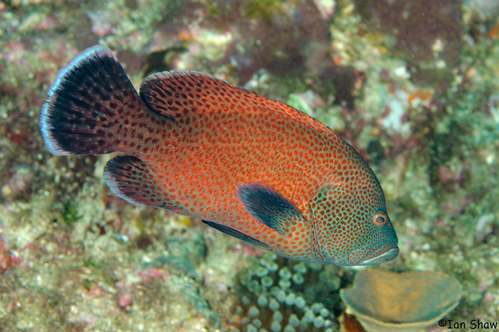Tomato Rockcod, Cephalopholis sonnerati (Valenciennes 1828)
Other Names: Orange-spotted Cod, Orange-spotted Rock-cod, Red Coral Cod, Red Rockcod, Tomato Cod, Tomato Grouper, Tomato Hind, Tomato Rock Cod, Tomato Rock-cod, Tomato Seabass

A Tomato Rockcod, Cephalopholis sonnerati, at North Solitary Island, New South Wales, depth 12 m. Source: Ian V. Shaw / Atlas of Living Australia. License: CC by Attribution-NonCommercial-ShareAlike
Summary:
A reddish-orange to reddish-brown grouper with a dense network of spots on the head, fainter spots on the body and fins, and bluish fin margins. Adults are deep-bodied with a hump-headed appearance. Juveniles are dark with darker spots and a broad paler blue margin on the caudal fin.
Video of Tomato Rockcods at Okinawa, Japan
A Tomato Rockcod being attended by cleaner shrimps
Video of Tomato Rockcods at Okinawa, Japan
A Tomato Rockcod being attended by cleaner shrimps
Cite this page as:
Cephalopholis sonnerati in Fishes of Australia, accessed 05 Jul 2025, https://fishesofaustralia.net.au/home/species/4658
Tomato Rockcod, Cephalopholis sonnerati (Valenciennes 1828)
More Info
|
Distribution |
Known in Australia from The Abrolhos Islands, Western Australia, to near Darwin, Northern Territory, and from Cape York, Queensland, to South West Rocks, New South Wales; also Lord Howe Island in the Tasman Sea. Elsewhere, the species is widespread in the Indo-Pacific, from Africa to the Line Islands, north to southern Japan, and south to northern New South Wales (Australia). Inhabits deep lagoons and steep outer reef slopes |
|
Colour |
Pelvic fins usually reaching or extending beyond anus. Color of adults in Indian Ocean: body orange-red to reddish brown, often with scattered small whitish blotches; head purplish to reddish brown with numerous close-set orange-red spots; membrane between lower 2 opercular spines usually darker than rest of head; fins usually darker than body, esp. the caudal and posterior part of dorsal and anal fins; pelvic fins often blackish distally. Color of adults in the Pacific: pale reddish to yellowish brown with numerous small brownish red spots on head, body, and fins. |
|
Feeding |
Feeds on small fishes and crustaceans including shrimps, crabs and stomatopods. |
|
Biology |
Forms spawning aggregations, and is likely to be a protogynous hermaphrodite. |
|
Fisheries |
Protected in Queensland by a size regulation, with a maximum catch size of 38 cm TL. |
|
Species Citation |
Serranus sonnerati Valenciennes, 1828, Hist. Nat. Poiss. 2: 299. Type locality: Pondicherry, India. |
|
Resources |
Tomato Rockcod, Cephalopholis sonnerati (Valenciennes 1828)
References
Allen, G.R. 1997. Marine Fishes of Tropical Australia and South-east Asia. Perth : Western Australian Museum 292 pp. 106 pls.
Allen, G.R.& Erdmann, M.V. 2012. Reef fishes of the East Indies. Perth, Australia: Universitiy of Hawai'i Press, Volumes I-III. Tropical Reef Research.
Allen, G.R. & Swainston, R. 1988. The Marine Fishes of North-Western Australia. A field guide for anglers and divers. Perth, WA : Western Australian Museum vi 201 pp., 70 pls.
Craig, M.T., Sadovy de Mitcheson, Y.J. & Heemstra, P.C. 2011. Groupers of the World: a Field and Market Guide. Grahamstown, South Africa : NISC Ltd 356 pp., Appendix 47 pp.
Fennessy, S., Min, L. & Russell, B. 2008. Cephalopholis sonnerati. The IUCN Red List of Threatened Species 2008: e.T132757A3442588. http://dx.doi.org/10.2305/IUCN.UK.2008.RLTS.T132757A3442588.en. Downloaded on 31 August 2018.
Heemstra, P.C. & Randall, J.E. 1993. Groupers of the World (Family Serranidae, Subfamily Epinephelinae). An annotated and illustrated catalogue of grouper, rockcod, hind, coral grouper and lyretail species known to date. FAO Fisheries Synopsis No. 125 Vol. 16. Rome: FAO. pp. 1-382.
Heemstra, P.C. & Randall, J.E. 1999. Family Serranidae. pp. 2442-2548 in Carpenter, K.E. & Niem, T.H. (eds). The Living Marine Resources of the Western Central Pacific. FAO Species Identification Guide for Fisheries Purposes. Rome : FAO Vol. 4 2069-2790 pp.
Hutchins, J.B. 2001. Biodiversity of shallow reef fish assemblages in Western Australia using a rapid censusing technique. Records of the Western Australian Museum 20: 247-270.
Hutchins, J.B. 2001. Checklist of the fishes of Western Australia. Records of the Western Australian Museum, Supplement 63: 9-50.
Johnson, J.W. 2010. Fishes of the Moreton Bay Marine Park and adjacent continental shelf waters, Queensland, Australia. pp. 299-353 in Davie, P.J.F. & Phillips, J.A. Proceedings of the Thirteenth International Marine Biological Workshop, The Marine Fauna and Flora of Moreton Bay. Memoirs of the Queensland Museum 54(3)
Kuiter, R.H. 1992. Tropical Reef-Fishes of the Western Pacific, Indonesia and Adjacent Waters. Jakarta : PT Gramedia Pustaka Utama 314 pp. pls.
Kuiter, R.H. 1993. Coastal Fishes of South-eastern Australia. Bathurst : Crawford House Press 437 pp.
Kuiter, R.H. 1996. Guide to Sea Fishes of Australia. A comprehensive reference for divers and fishermen. Sydney, NSW, Australia : New Holland Publishers xvii, 434 pp.
Lee, C.& Y. Sadovy. 1998. A taste for live fish: Hong Kong's live reef fish market. Naga ICLARM Q 21(2): 38-42.
Pollard, J. (ed.) 1980. G.P. Whitley's Handbook of Australian Fishes. North Sydney : Jack Pollard Publishing Pty Ltd 629 pp.
Randall, J.E. 2005. Reef and shore fishes of the South Pacific. New Caledonia to Tahiti and the Pitcairn Islands. Honolulu : University of Hawaii Press 707 pp.
Randall, J.E., Allen, G.R. & Steene, R. 1990. Fishes of the Great Barrier Reef and Coral Sea. Bathurst : Crawford House Press 507 pp. figs.
Randall, J.E., Allen, G.R. & Steene, R. 1997. Fishes of the Great Barrier Reef and Coral Sea. Bathurst : Crawford House Press 557 pp. figs.
Randall, J.E. & Heemstra, P.C. 1991. Revision of Indo-Pacific groupers (Perciformes: Serranidae: Epinephelinae), with descriptions of five new species. Indo-Pacific Fishes 20: 1-332.
Valenciennes, A. in Cuvier, G.L. & Valenciennes, A. 1828. Histoire Naturelle des Poissons. Paris : Levrault Vol. 2 xxi, 2 + 490 pp., pls 9-40.








